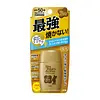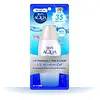What's inside
What's inside
 Key Ingredients
Key Ingredients

 Benefits
Benefits

 Concerns
Concerns

 Ingredients Side-by-side
Ingredients Side-by-side

Cyclopentasiloxane
EmollientWater
Skin ConditioningZinc Oxide
Cosmetic ColorantEthylhexyl Methoxycinnamate
UV AbsorberCetyl Ethylhexanoate
EmollientDipropylene Glycol
HumectantSilica
AbrasiveDimethicone
EmollientTitanium Dioxide
Cosmetic ColorantCetyl PEG/PPG-10/1 Dimethicone
EmulsifyingMagnesium/Aluminum/Zinc/Hydroxide/Carbonate
Polyglyceryl-3 Diisostearate
EmulsifyingDiethylamino Hydroxybenzoyl Hexyl Benzoate
UV FilterHydrogen Dimethicone
Myristic Acid
CleansingAluminum Hydroxide
EmollientTocopheryl Acetate
AntioxidantMethylparaben
PreservativeEthylparaben
PreservativePotassium Alum
AstringentParfum
MaskingButylene Glycol
HumectantDimethicone/Vinyl Dimethicone Crosspolymer
Skin ConditioningBHT
AntioxidantGlycyrrhetinic Acid
Skin ConditioningCamellia Sinensis Leaf Extract
AntimicrobialScutellaria Baicalensis Root Extract
AstringentCyclopentasiloxane, Water, Zinc Oxide, Ethylhexyl Methoxycinnamate, Cetyl Ethylhexanoate, Dipropylene Glycol, Silica, Dimethicone, Titanium Dioxide, Cetyl PEG/PPG-10/1 Dimethicone, Magnesium/Aluminum/Zinc/Hydroxide/Carbonate, Polyglyceryl-3 Diisostearate, Diethylamino Hydroxybenzoyl Hexyl Benzoate, Hydrogen Dimethicone, Myristic Acid, Aluminum Hydroxide, Tocopheryl Acetate, Methylparaben, Ethylparaben, Potassium Alum, Parfum, Butylene Glycol, Dimethicone/Vinyl Dimethicone Crosspolymer, BHT, Glycyrrhetinic Acid, Camellia Sinensis Leaf Extract, Scutellaria Baicalensis Root Extract
Water
Skin ConditioningAlcohol
AntimicrobialEthylhexyl Methoxycinnamate
UV AbsorberDipropylene Glycol
HumectantGlycerin
HumectantButyl Methoxydibenzoylmethane
UV AbsorberAcrylates/C10-30 Alkyl Acrylate Crosspolymer
Emulsion StabilisingTriethanolamine
BufferingEthylhexyl Triazone
UV AbsorberBis-Ethylhexyloxyphenol Methoxyphenyl Triazine
Skin ConditioningDisodium EDTA
Arginine
MaskingSodium Hyaluronate
HumectantHydrolyzed Collagen
EmollientSodium Acetylated Hyaluronate
HumectantButylene Glycol
HumectantPhenoxyethanol
PreservativeEDTA
Xanthan Gum
EmulsifyingBHT
AntioxidantWater, Alcohol, Ethylhexyl Methoxycinnamate, Dipropylene Glycol, Glycerin, Butyl Methoxydibenzoylmethane, Acrylates/C10-30 Alkyl Acrylate Crosspolymer, Triethanolamine, Ethylhexyl Triazone, Bis-Ethylhexyloxyphenol Methoxyphenyl Triazine, Disodium EDTA, Arginine, Sodium Hyaluronate, Hydrolyzed Collagen, Sodium Acetylated Hyaluronate, Butylene Glycol, Phenoxyethanol, EDTA, Xanthan Gum, BHT
 Reviews
Reviews

Ingredients Explained
These ingredients are found in both products.
Ingredients higher up in an ingredient list are typically present in a larger amount.
BHT is a synthetic antioxidant and preservative.
As an antioxidant, it helps your body fight off free-radicals. Free-radicals are molecules that may damage your skin cells.
As a preservative, it is used to stabilize products and prevent them from degrading. Specifically, BHT prevents degradation from oxidation.
The concerns related to BHT come from oral studies; this ingredient is currently allowed for use by both the FDA and EU.
However, it was recently restricted for use in the UK as of April 2024.
Learn more about BHTButylene Glycol (or BG) is used within cosmetic products for a few different reasons:
Overall, Butylene Glycol is a safe and well-rounded ingredient that works well with other ingredients.
Though this ingredient works well with most skin types, some people with sensitive skin may experience a reaction such as allergic rashes, closed comedones, or itchiness.
Learn more about Butylene GlycolDipropylene Glycol is a synthetically created humectant, stabilizer, and solvent.
This ingredient helps:
Dipropylene glycol is technically an alcohol, but it belongs to the glycol family (often considered part of the ‘good’ alcohols). This means it is hydrating and gentle on skin unlike drying solvent alcohols like denatured alcohol.
As a masking agent, Dipropylene Glycol can be used to cover the smell of other ingredients. However, it does not have a scent.
Studies show Dipropylene Glycol is considered safe to use in skincare.
Learn more about Dipropylene GlycolEthylhexyl Methoxycinnamate is an organic compound that provides UVB protection. It often goes by the more common name of octinoxate. It is created from methoxycinnamic acid and 2-ethylhexanol.
Ethylhexyl Methoxycinnamate absorbs UVB rays with wavelengths between 280-320 nm. UV absorbers protect your skin by using chemical reactions to convert UV rays into heat and energy.
UVB (290-320 nm) rays emit more energy than UVA rays. They are capable of damaging DNA, causing sunburns and are thought to be linked to skin cancer.
The state of Hawaii has banned sunscreens containing octinoxate due to its potential impact on coral reefs. More research is needed to bridge gaps in this research. The European Union allows higher levels of octinoxate in sunscreens than the US and Australia.
Ethylhexyl Methoxycinnamate is oil soluble. It is not stable and may lose efficacy when exposed to sunlight.
Learn more about Ethylhexyl MethoxycinnamateWater. It's the most common cosmetic ingredient of all. You'll usually see it at the top of ingredient lists, meaning that it makes up the largest part of the product.
So why is it so popular? Water most often acts as a solvent - this means that it helps dissolve other ingredients into the formulation.
You'll also recognize water as that liquid we all need to stay alive. If you see this, drink a glass of water. Stay hydrated!
Learn more about Water